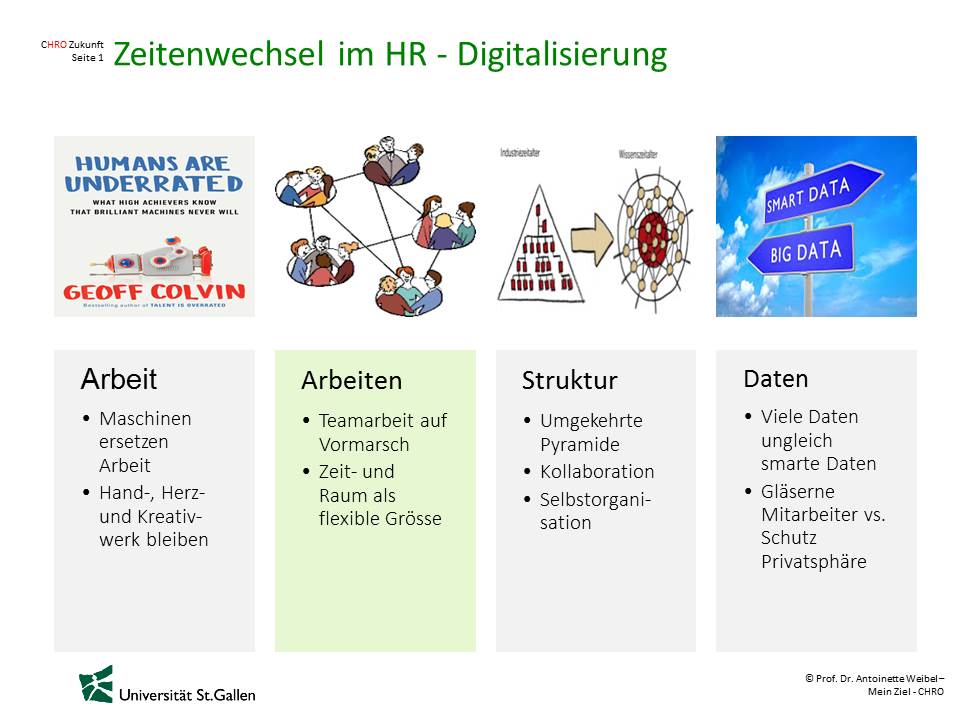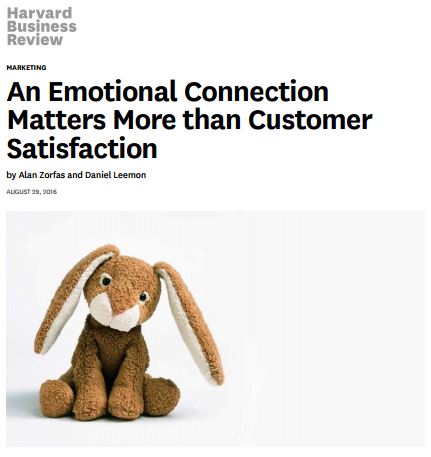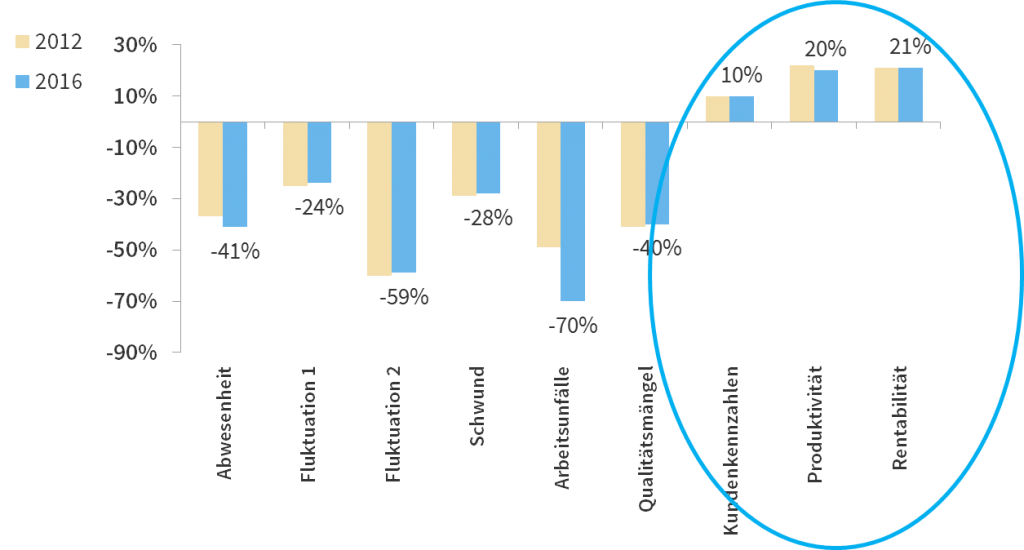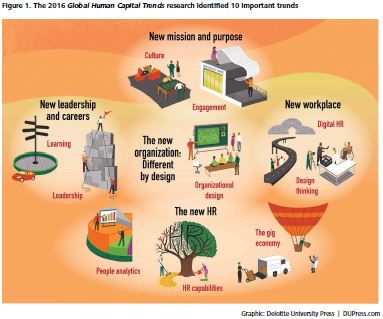TeamStreaming und Herausforderungen und Trends in der Wirtschaft und HR-Welt

Bei TeamStreaming wird die traditionelle Organisationspyramide mit der umgekehrten kundenorientierten Pyramide in einem «Looping»-Prozess verknüpft, um die Produktivität der Teams zu erhöhen. Dabei stellt das Produktivitätsthema eine Herausforderung, die alle betrifft. Als ich im Frühling 2013 diesen Ansatz aus der Praxis heraus entwickelt habe, wusste ich noch nicht, dass dieser Prozess, wichtige Trends in der HR-Welt reflektieren würde und eine mögliche Antwort auf die Produktivitätsherausforderung ist.
Heute werde ich immer häufiger mit Ergebnissen aus der Forschung konfrontiert, welche nicht nur die steigende Wichtigkeit von geteilter Leadership und kundenorientierter Arbeit in Teams bestätigen, sondern auch die Notwendigkeit von produktivitätssteigernden Massnahmen und Methoden unterstreichen. Methoden, die über die techonologische Entwicklung hinausgehen, wenn sich die demographische Entwicklung nicht verändert. Hier sind einige interessante Beispiele:
- Dr. David Blitzer, US Ökonom und Managing Director S&P Dow Jones Indices, 47. ISC Symposium, Universität St. Gallen, 5. Mai 2017
- Prof. Antoinette Weibel, Professorin für Personalmanagement, I.FPM, FAA, Universität St. Gallen, 26. Mai 2016 und 12. Dezember 2016

Die Quintessenz von Prof. Antoinette Weibels Ausführungen ist, dass in Zukunft neben flexiblen Arbeitsformen im Team, welche auf die Kundenzufriedenheit und auf die umgekehrte Organisationspyramide ausgerichtet sind, Vertrauen und Engagement zur Förderung von Innovation und Leistung eine primäre Rolle für den Unternehmens- und HR-Erfolg spielen werden.
Die Präsentation vom 12. Dezember 2016 im Druckformat finden Sie hier: CHRO – Zukünftige Rolle und Herausforderungen
Die Präsentation vom 26. Mai 2016 mit interessanten Inputs zu Zielen und Leistungsmanagement: HR Zukunft und keiner geht hin?
- Matthias Mölleney, Präsident der ZGP – Zürcher Gesellschaft für Personal-Management und Leiter des Centers für HRM & Leadership an der HWZ, PersonalSwiss 4. April 2017

Matthias Mölleney Auszug Leadership und Digitalisierung PersonalSwiss 2017
Das emotionale Engagement der Mitarbeitenden rechnet sich: Es beschleunigt die Performance und verbessert die Leistungsergebnisse.
Fluktuation 1: Unternehmen mit hoher Fluktuation / Fluktuation 2: Unternehmen mit niedriger Fluktuation / Produktivität inkl. VerkaufQuelle: Gallup Meta-Analyse 2012/2016 weltweit
In Deloitte’s Jahrespublikation zu den grossen Trends in der Personal- und Organisationsentwicklung schreiben Josh Bersin und seine Kollegen:
«Organizational design: The rise of teams
This new mode of organization—a “network of teams” with a high degree of empowerment, strong communication, and rapid information flow—is now sweeping businesses and governments around the world. It is built on several fundamental principles:
Move people into customer-, product-, or market- and mission-focused teams, led by team leaders who are experts in their domain (not “professional managers”).
Empower teams to set their own goals and make their own decisions within the context of an overarching strategy or business
Plan, reversing the traditional structure of goal and performance management.
Replace silos with an information and operations center to share integrated information and identify connections between team activities and desired results.
Organize these teams around mission, product, market, or integrated customer needs rather than business function.
Teach and encourage people to work across teams, using techniques like “liaison officers” (the US military), “hackathons,” open office spaces that promote collaboration (Apple Inc. and Cleveland Clinic), and job rotation to give teams a common understanding of each other
Enable people to move from team to team as needed—similar to the way experts come together on Hollywood movie sets or in global consulting firms—and then ensure that people have a home to return to once a team-based project is done. This changes the concept of a “job description” to that of a “mission specialist” or “technical specialist».
Shift senior leaders into roles focused on planning, strategy, vision, culture, and cross-team communication.»
- Alan Zorfas und Daniel Leemon: An Emotional Connection Matters More than Customer Satisfaction, Harvard Business Review, 29. August 2016

Der Beitrag unterstreicht die Bedeutung von Emotionen zwar auf Kundenebene, das Thema kann jedoch sehr einfach auf Leadership und Mitarbeitenden übertragen werden. Emotionen lassen sich übertragen und wirken ansteckend. So schreiben sie:
«Shaping a customer experience by being precise about the emotional connections you’re trying to build and investing in the touch points that drive these connections is a powerful way to increase customer value, and maximize the return on investment decisions and minimize the risk. Emotionally connected customers not only generate greater value, but in every interaction become more and more convinced that “this company gets me”.»
- Amy C. Edmonson: The Three Pillars of a Teaming Culture, Harvard Business Review, 13. Dezember 2013

«Coordination and collaboration are essential, but they happen in fluid arrangements, rather than in static teams.» Prof. Amy C. Edmonson, Novartis Professor of Leadership and Management, Harvard Business School
«Teaming is about identifying essential collaborators and quickly getting up to speed on what they know so you can work together to get things done. This more flexible teamwork (in contrast to stable teams) is on the rise in many industries because the work – be it patient care, product development, customized software, or strategic decision-making – increasingly presents complicated interdependencies that have to be managed on the fly. The time between an issue arising and when it must be resolved is shrinking fast. Stepping back to select, build, and prepare the ideal team to handle fast-moving issues is not always practical. So teaming is here to stay.
Today’s leaders must therefore build a culture where teaming is expected and begins to feel natural, and this starts with helping everyone to become curious, passionate, and empathic.
Curiosity drives people to find out what others know, what they bring to the table, what they can add. Passion fuels enthusiasm and effort. It makes people care enough to stretch, to go all out. Empathy is the ability to see another’s perspective, which is absolutely critical to effective collaboration under pressure.
The leader’s task is to model these behaviors. (…)
When you join an unfamiliar team or start a challenging new project, self-protection is a natural instinct. It’s not possible to look good or be right all the time when collaborating on an endeavor with uncertain outcomes. But when you’re concerned about yourself, you tend to be less interested in others, less passionate about your shared cause, and unable to understand different points of view. So it takes conscious work to shift the culture.»
TeamStreaming knüpft gerade an solchen Punkten an und bietet einen möglichen Ansatz, die Herausforderung «Teamgestaltung und -produktivität» erfolgreich zu meistern.
Möchten Sie mehr darüber erfahren? Dann freue ich mich auf Ihre unverbindliche Kontaktaufnahme.
Teilen


